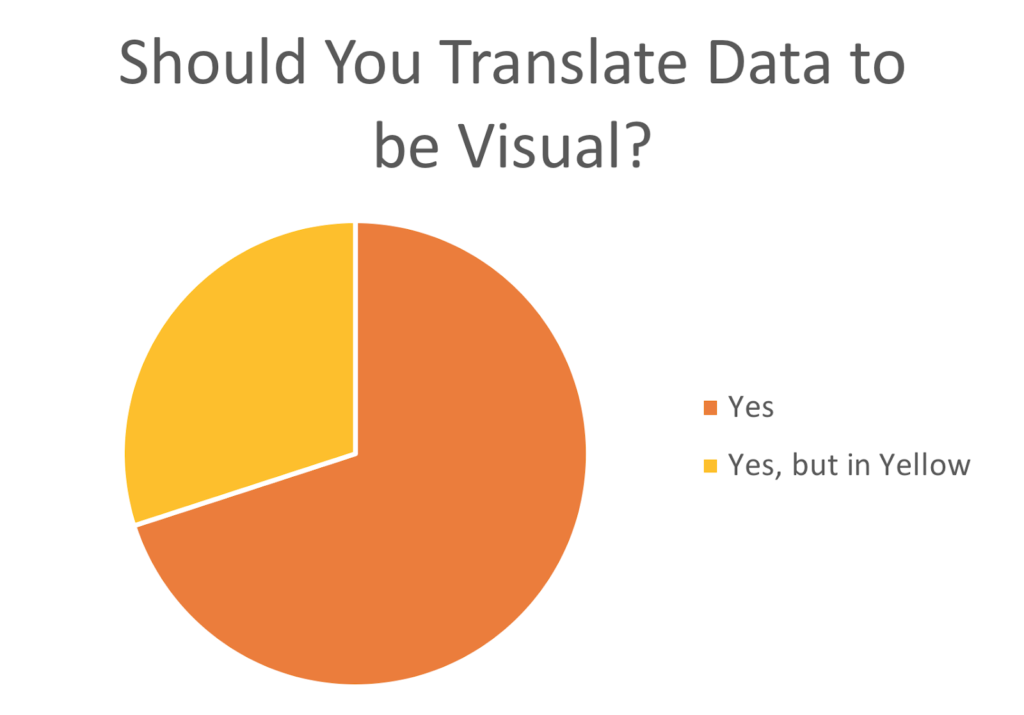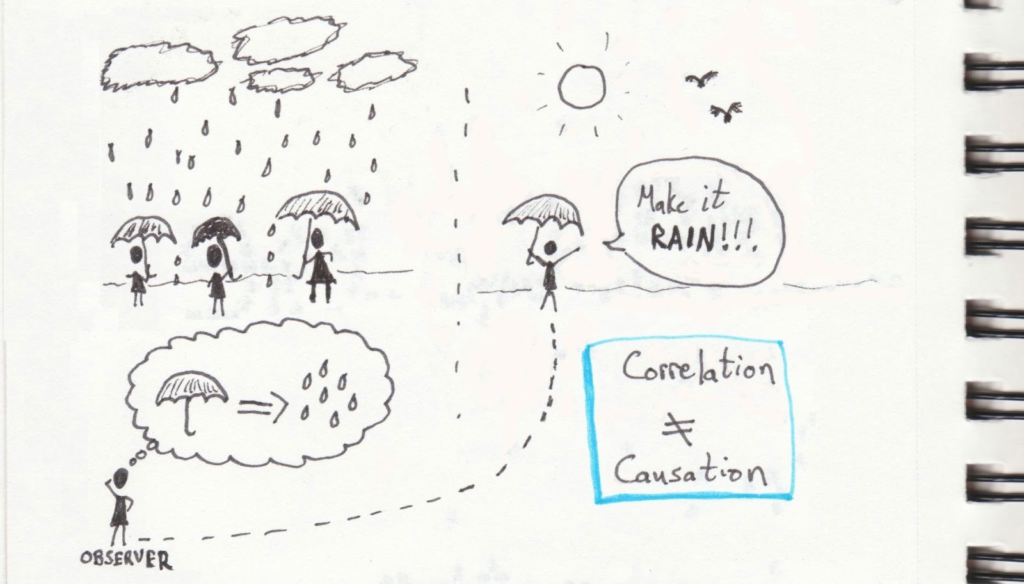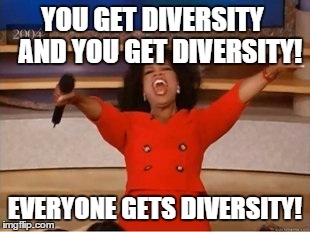Tuesday, December 18, 2018
Monday, December 10, 2018
Why I Became An Academic Personal Trainer
As an enthusiastic learner, I will always jump at every opportunity to enhance my learning experience. With that being said, when provided with the amazing opportunity by A Team Tuition, I was more than honoured to become an Academic Personal Trainer to fulfil my passion of equipping students with the abilities to strive above and beyond, whilst expanding my own academic knowledge!
As an enthusiastic learner, I will always jump at every opportunity to enhance my learning experience. With that being said, when provided with the amazing opportunity by A Team Tuition, I was more than honoured to become an Academic Personal Trainer to fulfil my passion of equipping students with the abilities to strive above and beyond, whilst expanding my own academic knowledge!
There are many reasons as to why I became a tutor, and I’ll start with one of the most outstanding ones – the dual advantage effect!
No one is an expert in everything. When one of my students comes across a problem or question I am not able to fully solve, it provides me with an opportunity to expand my own knowledge by exploring something new every day.
This means I will be continually increasing my knowledge base, which is just the perfect way to keep myself intellectually active. Plus, the subsequent feeling of satisfaction that follows after my student and I figure out the solution together is absolutely invaluable – just as hitting two birds with one stone (both my student and I gaining additional knowledge)!
Moreover, by tutoring students ranging from primary school to University level in numerous subjects, I am able to gain a better understanding of the curriculum’s from different schools so to familiarise myself with the various teaching styles and marking schemes, which works out to be extremely helpful when advising my students exactly what their teachers are looking for.
Another one of the many perks of being a tutor includes cultivating valuable relationships. The most enjoyable tutoring experiences I have are those where I effectively connect with my students, allowing us to become friends from a tutor-student relationship.
This is extremely beneficial to a tutor, as sometimes students are more likely to appreciate advice and mentorship from a friend rather than instructions from one who they perceive as seemingly superior to them. Besides, it is always great to help out another friend!
Amongst the best things about one-on-one tutoring is the flexibility that follows. Amidst juggling University assignments and all other commitments, it may be overwhelming at times. However, fear not as being a tutor makes scheduling for work an absolute breeze.
We are often able to schedule tutoring classes at the convenience of both tutors and the students while maintaining consistency – which is much more flexible than the conventional fixed rosters.
Furthermore, all the tutors in A Team Tuition are always more than willing to help one another when one of us encounters a tricky problem-solving question – simply post the question on our crew page and get ready for answers!
This way, we create a friendly and supportive environment that encourages all tutors to lend a helping hand to those in need.
A Team Tuition has a vast amount of resources available to its students and tutors, which has been very helpful as it gives tutors access to all kinds of materials such as the textbook database and mock exams to help in bettering our respective students.
For those of us who are interested in teaching or working in a classroom, tutoring is the perfect chance to develop as much experience as possible in order to determine whether it would be the right path. If you are already on the way to becoming a teacher, then tutoring provides you that extra edge of experience for the future.
It is also a wonderful opportunity to work with both individual students as well as a group of students through School Partnerships. I think it is safe to conclude that the opportunities are endless for a tutor, especially here at A Team Tuition as we continue to grow and expand!
In my opinion, tutoring is very different to a conventional classroom setting. Each session is uniquely designed to be solely focused on bettering the one student.
Such a learning experience allows students to raise as many questions as they want to quench their curiosity, and there is nothing more satisfying than witnessing the look of understanding pass across a student’s face with a ginormous smile. That being said, students can begin to build their confidence and apply their knowledge outside of the tutoring lessons.
As a result, being a tutor means being able to feel as if I am making a real difference in each student’s life, ultimately rewarding a warm sense of gratification and pride.
To say the least, being able to draw on both my subject expertise and creativity to excite enthusiasm, understanding and intelligence in my students presents the role of tutoring as a uniquely inspiring and immensely rewarding career – and that is why I became an Academic Personal Trainer.
The post Why I Became An Academic Personal Trainer appeared first on A Team Tuition.
from A Team Tuition https://ift.tt/2zTLym9
via IFTTT
Tuesday, December 4, 2018
The 10 Ways A Team Tuition Helped Me Land My Dream Job After University
Part time jobs are a necessity for most, but only a select few use the opportunity to gain experience while they’re studying at uni. Our dream employers always ask us in interviews what experience we have gained while at university and unfortunately, our answers rarely satisfy their requirements.
Rather than tell you explicitly what skills and experiences I have gained through working with A Team Tuition, I want to take you through my journey and how my time led me to my dream job. Hopefully you are somewhat inspired by this blog to use your time at university effectively and that A Team Tuition can be the pathway to your dream career.
The post The 10 Ways A Team Tuition Helped Me Land My Dream Job After University appeared first on A Team Tuition.
from A Team Tuition https://ift.tt/2EfEDHE
via IFTTT
Thursday, November 22, 2018
How To Get An A In Geography – 7 Steps
Each subject, regardless of its relevance to your desired career, can teach us something.
English teaches us communication; mathematics shows us how to solve problems, Science explains the world around us and the arts push us to our creative limits. Geography is no exception. Geography gives students a global mindset through not only the study of the world’s environmental and social standings, but it’s potential.
We, at A Team understand that showing your skills in Geography is difficult…but we know it is doable. The study of Geography encompasses English, maths, history, science and more, which makes achieving an A so tricky. Don’t let this deter you. Geography is rewarding, exciting and so relevant to the evolving world around us.
1. Know your History
I can already hear the “Isn’t this how to get an A in Geography?” already. But it’s true, for one to understand the world around them, it’s imperative that one knows where it has been to know where it is going.
If you’re not the biggest fan of Geography, then I highly doubt you’re a History supporter either. However, the correlation and even causation (more on that soon) between the two is uncanny. Geography and History often get placed in the English/Maths or Cat/Dog category, like they are polar opposite subjects to only be studied one semester at a time.
This couldn’t be further from the truth. History dictates the future and fundamentally can shape the Geography around us. Take Climate change, for example, it might be an overused topic but its relevance is undeniable. This graph from NASA tells us that History is shaping our Geography.
You can see that Carbon Dioxide levels are twice as high as they ever have been in the past 68 years. Using this historical information, we can make not only make predictions and assumptions about the Geography of the world now but also the future!
2. Visualise
Speaking of graphs, the second tip is to translate as much data as you can into visual forms.
See what I did there?
Geography is challenging to understand based on numerical data. Once translated into a visual depiction not only does it allow you to understand the data you are working with, it makes communicating your ideas and findings easier and more enjoyable for the reader.
At A Team Tuition, we believe in the three learning languages, the first being Aural (people who learn best by listening – the ‘sponge’ brain type), the second is Kinaesthetic (people who learn best using hands-on work) and finally is Visual learners (those who learn best by creating diagrams and visual representing data). Most people thrive and understand information best using visual stimuli, hence the pie graph above!
The type of data that goes into graphs and visual formats is data that is comparative with itself and other forms of data. Think to compare populations, or looking at trends over time.
The choice made in graph selection is CRUCIAL. I was once under the impression that all graphs are created equal. This is not the case.
For representing data comparing single numbers such as populations, use a column or bar graph. For data that in total represents a whole of something (100%), for example comparing how many people have access to clean water, use a pie graph. For showing a trend over time either growing or shrinking use a line graph.
3. Break It Up
When it comes to the placement of your graph, breaking up your Geography assessment is also of crucial importance. Unlike English where essays or presentations follow a linear pattern, Geography is much more structured and requires much more planning and breaking up of topics in assessment.
If you were to be creating a field report collating data from tide levels at your nearest beach, breaking up going about the assessment is fundamental to an organisation which will, in turn, result in an efficiently crafted report.
With Geography, your plan of attack should always start with research. Consider knowledge like a flashlight and your assessment like a dark tunnel. Without any prior knowledge, once you have commenced writing your assessment, you will quickly find yourself lost and unsure of not what to write, but where to put your data or analysis.
Every one of us at A Team would agree that once research is underway, this is where you can start to break up doing the assessment into manageable chunks. I recommend setting goals with tangible targets such as “complete section 2-B.” rather than “complete 30 minutes of work”. This will not only allow you to plan the assessment more efficiently, but also make you feel a lot more accomplished after your work.
4. Know Your Lingo
Maths has B.O.M.D.A.S., while English has P.E.E.L. Geography has many terms and jargon that students striving for an A should know. Most of these that are pertinent to your topic will be found in glossaries, which are the definition section at the back of most textbooks.
Some of our favourites at A Team are:
- B.O.L.T.S.S. – when creating a map make sure to include ‘B.O.L.T.S.S.’, as listed below:
- Border
- Orientation
- Legend
- Title
- Scale
- Source
- Biomes – a large naturally occurring group of flora and fauna
- Forest
- Desert (not to be confused with dessert, although tasty they are two very different things)
- Ocean
- Socio-Economic – the relationship between a group of people and their economic status
- Biodiversity – having a broad ecosystem that is self-sufficient and broad with many flora (plants) and fauna (animals)
5. Correlation ≠ Causation
Often used throughout Geography papers worldwide this data analysis error is easy to make and hard to cover up. When analysing data and similarities are found, there is either a correlation or causation.
Correlation is the idea that two sets of data follow a similar pattern yet do not influence each other. Causation is the idea that one set of data will influence another. Take a look at this data set below; it shows the Divorce rate in Maine and levels of margarine consumption.
Although the data is near identical, it would be preposterous to assume that higher consumption of margarine = a higher divorce rate. This is a prime example of correlation. Causation, however, is where one data set influences another.
For example, rising heat levels may cause rising sales of ice cream, and the more you study with an academic personal trainer at A Team, your grades can increase! It is necessary to note the difference when faced with it, but that shouldn’t stop us from laughing at a few examples.
6. Understand the Importance of the Topic
When studying Geography, every topic has its purpose. Geography is relevant and pertinent to every person on Earth. Pollution, extinction, famine and illness are all topics you will come across in your geographical endeavours. On paper, these issues can be dry. However, they are some of the most critical issues in the modern world.
Take Climate Change for example. The United Nations have just released a report outlining the dangers and imminent threat of climate change such as temperatures rising 1.5° after 2030.
The relevance of the topic is why most assessment will ask for predictions or recommendations (known as interpretation and analysis), to put the issue into a worldly context. Of course, the importance of each topic is subjective.
7. Diverse Sources Are Key
Finally, it is recommended to have as much diversity in your sources as possible. It may seem that your teacher is looking for as many sources as you can cram into your research book. What your teacher is looking for is a diverse range of sources. Using 3 to 4 compared to 1 to 2 references to prove a point makes for a stronger argument.
As much as we all wish every source were equal in academic reliability, this isn’t the case.
Repeat after me:
Not all information is made equal in reliability!
Wikipedia is a solid starting point to gain a rough understanding of the topic. However, that’s where your relationship with the free encyclopedia should end. Using both information available on the internet and information in books you will have a dynamic and diverse range of sources which is key to an academically strong assessment.
We at Team Tuition believe that Geography studies is all about proving yourself right. Using your sources, understanding the relevance of the topic and its specific data you should have no problem capturing that A.
Good luck!
The post How To Get An A In Geography – 7 Steps appeared first on A Team Tuition.
from A Team Tuition https://ift.tt/2TBRRTh
via IFTTT
Tuesday, November 20, 2018
How To Get An A In Business – 7 Steps
Almost every aspect of the society in which we live involves some elements of business, including undertakings as simple as trading a candy for a chocolate you would much prefer.
In saying that, developing a thorough understanding in the subject of Business will not only allow you to open your eyes to the structurally different ways in which society functions, it uncovers the rationales as to why the society behaves the way it does.
Doesn’t that sound pretty exciting?
However, speaking from personal experiences, Business is often perceived as a “boring” subject in which “you don’t need to try hard to get a good grade”.
Well, hold that thought, as this article will impart onto you the approaches to effectively achieve an A in business, while drifting away from a stereotypical notion like the one above.
While it may not appear to be an extremely challenging subject, getting a good grasp of all of the interrelated concepts may require more time and effort than simply adhering to the idea that “business is all about trading for individual benefits”.
“Where do I start?” I hear you ask. Begin by following these 7 simple steps and you will see yourself scoring with flying colours in Business in no time!
Step 1: Speak and think like an economist
It is no doubt that the topic of economics constitutes a large portion of the Business subject. Therefore, the first step to mastering economics is to think like an economist.
Begin with familiarising yourself with fundamental concepts such as the scarcity principle, opportunity cost, cost-benefit principle, economic surplus, dead weight loss, rational decision-making criteria, etc. Visit the “How to get an A in Economics” blog here to learn more!
While the combination of such phrases may appear confusing and overwhelming at first, their respective meanings are often within the word. Besides, applying them to real life scenarios will make them much easier to comprehend! It is as simple as, scarcity principle means resources are scarce and so getting more of one thing means getting less of another.
See, that wasn’t so difficult, was it?
Now, the next step would simply be to write like an economist in assignments and exams – master the language of economics. How might one do that? Take the knowledge you already possess about the basics of economics, and simply transform them into words!
A quick and easy way that I’ve found to learn new terms is to create your own flashcards and utilize Quizlet to enhance your memory on them. Then, use them appropriately in your writing to demonstrate your extensive knowledge and understanding of various economic concepts. Forget the terms? Revisit Quizlet!
Trust me when I say this, most of the ‘Knowledge and Understanding” criteria is achievable through the profound use to words in conveying ideas. Show your markers what you know and impress them!
With that being said, you can easily do the same for other topics in Business, by mastering the language of Accounting, Finance, Marketing or Management.
Step 2: Take advantage of your resources (teachers, librarians and classmates)
I can safely conclude from my schooling years that teachers are your most valuable resources.
Much of what I have learnt while striving for excellence includes that, those who possess the same knowledge as you are your greatest allies in achieving the best possible grades.
That includes your subject teacher, librarians who can direct you to external resources, and last but not least, your classmates learning alongside you.
Teachers are selflessly dedicated to your success. They are the ones who will be silently proud as they watch you soar through your schooling years. Similarly, they are always around the corner to give you a hand.
Take note of all the theories and exercise questions you don’t understand, and ask your teachers for help in resolving your confusion. If you don’t find an opportunity to do that, stay 10 minutes after class, or spend 15 minutes of your lunch break to ask your questions.
Better yet, send your teachers an e-mail to book 15 minutes of their schedule. From what I have learnt, teachers will be more inclined to assist those who they observe as dedicated to greatness.
As you build a good relationship with your teachers by demonstrating your will to improve, they will often look harder for marks in between your lines of answers in assessments. Don’t believe me? Give it a go!
What’s more, librarians are often more useful than you might presume. Sure, the most you hear them speak is when they tell you to keep quiet in the library. But librarians are library-ians, like living libraries!
Take full advantage of their wisdom in books by inquiring librarians for resources other than those prescribed by your teachers. You can surely depend on them to direct you to books that explore the field of Business in more depth than what you are learning in the classroom.
Last but not least, it is inevitable that you work in groups and teams in the workplace. So why not start now?
Form study groups!
No matter what grade you are in, cooperative learning is your best friend. It will help you more than you think. Two brains are better than one, right? Imagine six!
Not only does cooperative learning enhance a learner’s emotional and social performance, it fosters positive relationships as you and your friends work together to surpass your limits by sharing knowledge.
So go ahead and form study groups that will guarantee an eye-opening experience through your schooling years!
Step 3: Remain one step ahead (or four)
I know what you are thinking, it is not easy to remain one step ahead when there are just so much to do!
While it may be inevitable that you find yourself neglecting one subject to focus on others as your assessments begin to pile up (we’ve all been there!), you can just as easily make sure you are well caught up with Business before the impending assessments begin to overwhelm you!
Simply follow these 4 simple steps:
-
Do your homework.
Malcolm Gladwell’s Famous “10,000 Hour Rule” holds that 10,000 hours of “deliberate practise” are needed to become world-class in any field.
Just as an athlete cannot be trained in the matter of one day, an “A” in Business does not arrive naturally without practise.
One of the most important lessons I’ve learnt in Business is to never overlook your homework simply because you do not get graded on them, or your teacher “never checks anyways”.
There is a reason that teachers set homework, and that is for you to practise all that you have learnt in class so to familiarise yourself with the new concepts. Otherwise, how else will you put all the accounting and economic formulas to use?
Besides, it is more likely for you to be able to predict the style of questions in your exams by doing the homework questions your teacher has carefully chosen for the class.
Your homework often reflects what your teachers consider relevant in preparation for your assessments, so you will be doing yourself a massive disservice by neglecting them!
It doesn’t take long to complete your homework if you refrain from picking up your phone for 30 minutes. I speak from experience!
-
Read the criteria sheets of your assignments once you receive them.
You might wonder, “why would I do that when I don’t plan on starting this assignment until a week before the due date?”
Even if that is the case (though you should never do that!), you already know what is expected from an “A” assignment by reading the criteria sheet.
How would you put that to use?
Starting from then – begin to complete your homework according to the “A” criteria, and you are well and truly on your way to answering assignment and exam questions to an “A” standard!
This way, you will be inclined to respond to essay/short answer questions in ways that satisfy all of the criteria. This is especially pertinent when analysing market conditions of a given economy, offering accounting advice to businesses, postulating marketing strategies for firms, etc.
With the criteria requirements for an “A” in mind, you can remain one step ahead by applying them to your non-graded work, and you will see yourself doing the same for your graded assignments without even noticing!
-
Leave yourself 24 hours before the due date.
It is vital that you complete your assignment at least 24 hours before the due date.
Why?
Because that’s how long it takes to read all that you wrote from an unbiased point of view.
While you elaborate the ways in which businesses respond to changing economic conditions and improve productivity through organisation management, you are writing from your opinion and the research you gathered. It is therefore no doubt that you understand your own point of view.
But, it is far more significant that your teachers understand your argument, they are the ones marking your assignment after all!
Accordingly, proof-read your assignment 24 hours after its completion as if you are reading it for the very first time. It is then you will pick up on mistakes such as sentences that do not flow and ambiguous explanations. Fix them and make your assignment immaculate!
Better yet, request for your family and friends to read them and ask for advice, or think of more creative ways to further improve your assignment.
Of course, these steps are contingent on your prompt completion of your assignment so to leave yourself ample time for additional enhancements.
-
Refer to your Academic Personal Trainer
If you are feeling a little unsure about achieving the above steps on your own, never hesitate to request for an Academic Personal Trainer!
We are here to enhance your learning experience and will be more than happy to help you through your studies using these step-by-step processes.
Step 4: Broaden your learning
I’m sure many of you will agree with me when I say the content covered in Business is very much common sense in that you can easily observe the behaviours of the market and society to be able to comprehend most principles.
In saying that, it is often within the realm of one’s general knowledge to recognise that “Revenue – expenses = profit”, and that “demand increases as price decreases”.
Though you may not have noticed it, Business principles such as these are applied on a day-to-day basis.
For instance, it will be in your best interests to sell a bar of chocolate for a price above its cost (expenses) in order to generate an accounting profit; similarly, it is economically rational that sales (lower prices) attract more consumers (increased demand).
However, fear not if you are still a little confused, for you can easily broaden your learning!
Given its prevalence within everyday-life, our society is constantly operating within the field of Business.
In view of that, I encourage you to expand your curiosity outside the classroom by asking questions about the business decisions that revolve around you.
Don’t understand how governments calculate the appropriate amount of tax to be imposed on carbon emissions so to achieve both environmental benefits and economic efficiency? Ask!
Confused about why home owners tend to hold onto their properties for 5-10 years before putting them in the market, while other assets such as cars and office equipment would simply depreciate over time? Ask!
It is the profound understanding of such daily decisions that confer upon you the knowledge you need to be able to present reasoned arguments and evidence-based conclusions in a range of appropriate formats using economics and business conventions.
Do not be afraid to ask, as Thabo Mbeki proposes:
“I think that probably the most important thing about our education was that it taught us to question even those things we thought we knew. To say you’ve got to inquire, you’ve got to be testing your knowledge all the time in order to be more effective in what you’re doing.”
You can ask anyone around you – your teachers, parents, classmates, and even your academic personal trainer! Never settle until you are satisfied with a solution to your inquiry.
Start by developing questions and hypotheses about an economic or business issue happening around you, and find your own answers. You’ll be surprised how much this will help in your exams when that is exactly what is required of you.
But that’s not just it!
There are a million other ways to broaden your learning outside the classroom – it all depends on how badly you want that “A”!
If you are a reader, search for articles that report on major Business revolutions. Read about how Alan Joyce’s decision to ground its entire fleet became one of the best Business decisions for Qantas, and how Elon Musk utilised his expert power to march his company to success.
If you are a visual learner, watch videos that explain the Business concepts. Take your pick between animated videos and the all-serious, full-of-words videos!
As a creative learner myself, I often find that it takes me less time to absorb information from videos than learning from the books.
With that being said, I leave it in your hands to find what’s most efficient and effective for you, and implement your strategy (and no, this is not an excuse to not do your homework!).
However, don’t stress if you have no idea what works best for you, for you can simply visit the A Team blogs on learning languages to determine which category you fall into!
Step 5: Take the extra mile in your work
If you have been doing all the steps above (or more), I have good news for you – you are already taking the extra mile for your Business subject!
But, there is always room for improvement. I know this might sound harsh at first, but it is your will to succeed that pushes you beyond your boundaries. Just remember, a pot of gold is always at the end of the rainbow.
Firstly, go beyond the task in your Business assignments.
It is not enough to gather relevant data and information without interpreting them to identify relationships and trends, for this may only entitle you to a “C” standard in the criteria of “Analysis, synthesis and interpretation”.
Similarly, as you generate a range of viable options in response to economic or business matters, the criteria of “Economic reasoning, decision-making and application” is not fully satisfied until you use cost-benefit analysis to appropriately recommend and justify a course of action as well as predict the potential consequences of the proposed action.
To sum it up – don’t just do the bare minimum.
Constantly re-read your responses and think of different ways to cover a wider context, but do it succinctly.
This is achievable through extensive research followed by qualitative analysis.
While you will undoubtedly be conducting research for your assignments, don’t stop once you have found your answers!
Delve deeper into your research to uncover the how’s and why’s behind Business decisions, as this will only strengthen the arguments you put forth.
If that works out to be more time-consuming than you what you have allocated for this assignment, you may achieve the same effect by reading peer-reviewed articles that explore the intended and unintended consequences of economic and business decisions.
Furthermore, reading other essays online allows you to view similar Business issues as those set out in your assignments from another perspective, therefore inspiring you to broaden the scope of your analysis.
If you are willing to take this extra mile when completing your assessments, then you are one step closer to achieving that illusive “A” in Business!
Step 6: Be organised
Being organised and getting on top of your studies are of course, essential to achieving the best possible grade.
I have always been one who plans my schedule to the minute (I guess you can say I’m a little OCD). In doing so, I set hourly objectives or daily goals to be achieved, such as finishing my research after breakfast and completing my introduction before lunch.
It is because of the effective outcomes I achieve according to my schedule that I strongly recommend for you to plan ahead.
Draw up your own personal timetable using Excel Spreadsheet, Google Timetable, or even just with sticky notes.
Make sure you leave some time every day to work on your Business assessments (that includes homework), and don’t forget the 24-hour rule – create your own due date that is before the actual due date.
Most importantly, make it a habit to stay on top of your schedule – time management is key!
Step 7: Make quality notes
Treat your notes as your second brain.
It is inevitable that you will forget the minor details mentioned in class by your Business teachers, if you don’t make a habit out of jotting everything down in class, or if you write your notes only when you arrive home after a long day at school.
With all the new information you must absorb from all your subjects, you are bound to miss out some specifics by not making notes immediately. Trust me, “mental notes” don’t work out for everyone!
It is therefore imperative that you make full use of your second brain. After all, it retains all the information you put in it forever!
I can’t stress enough how important making quality notes will be to achieving an “A” in Business. Not only will they be a massive advantage when studying for your upcoming exams, you can always access them to refresh your memory when the next unit/topic builds on the knowledge you learnt this term.
I always find it useful to make a list of all the relevant formulas, whether they be economic or accounting ones, and attach that list onto the wall right above my study table. This way, you will see them every day and by the end of the term, you could literally have a photographic memory of them!
Another important thing to remember when making your notes – colour coding. Highlighting your notes and grouping them in a way that makes sense to you is a huge helping hand when you revisit them.
For example, think:
Supply and demand = yellow
Financial statements = green
Organisational management = red
These are just random examples, but you get the point!
Finally, if you have read through this whole blog while making note of all the tips you find useful, you are already on your way to becoming Business-savvy! The next step now is simply to apply what you have learnt and see yourself becoming an “A” Business student in no time!
The post How To Get An A In Business – 7 Steps appeared first on A Team Tuition.
from A Team Tuition https://ift.tt/2DxsmNo
via IFTTT
Wednesday, October 24, 2018
How To Get An A In Physics – 7 Steps
A lot of people say that it’s impossible to get an A in high school physics. This couldn’t be more wrong. Physics is a hard subject, not even the most optimistic tutor (me) would ever deny that. But if you work hard and follow these steps, you’ve got great odds of landing that fabled A.
1. Make good notes
This step is a pretty good start for any subject, but it’s particularly important for physics. Physics classes can be pretty intense, and it’s easy to end up blankly staring into space while the equations roll around you.
That’s obviously not the best situation, but it can be hard to avoid once the teacher really hits their kinematic-equation-stride. However, if you get the key points written down, you’ll be able to come back later and work through it at your own pace. In particular, if your teacher writes an equation on the board, get that written down, it is DEFINITELY important. Make sure you write down what they stand for too, so you don’t end up with a “Where did that C come from? What does that even mean?” kind of situation. Ideally, you’re getting everything important your teacher says written down, but if you get these key points, you’ll be able to come back and figure it out later.
2. Understand your formulae

The next step is figuring out how your formulae work. Get used to breaking apart your equations, figuring out how the different pieces work together, and working out what units your answer is going to have.
Familiarise yourself with different ways the formula is commonly rearranged, and other formulae that tend to link in with it. For example, if you’re working with the equation for friction (frictional force is equal to the coefficient of friction times the normal force), then practice rearranging that equation a few different ways, so you’re used to it in all its common forms.
This is an equation for a force, so other equations that use force (like F=ma, for example) might be useful things to be able to substitute in. If you can do this step, then the next one will become much easier.
3. Practice using them. A lot.
It’s pretty much exactly the way it sounds, but it’s really worth emphasising. If you don’t practice using the equations you’ve been given, over and over again till you cringe at the very mention of the word “friction,” you won’t get an A for physics. It’s as simple as that.
Do the problem questions your teacher hands out as homework. Find more in your textbook and do them too. Check your answers and make sure you’re doing them right. If you can do that, then congratulations, you’re already most of the way to getting that A. There’s still a few more tips and tricks that’ll help you along the way though.
4. Look for “reasonable” numbers
Physics is an easy subject to make lots of little errors in, and those silly mistakes really start to add up when they’re costing you a mark or so at a time. Because you probably won’t have time in an exam to check your work as rigorously as normal, the best way to avoid them is to know what sort of answers you expect for these sorts of questions.
If you’re doing a friction question, and your calculator tells you that the object will be experiencing 758, 437N of frictional force, you should probably take a step back and go “huh, that’s really, really high.” Generally, your answers for certain types of questions are all going to fall within a certain range, and anything outside that is a clue that something’s gone wrong.
If you’ve done a hundred friction questions, and gotten answers between about 2N and 15N every time, then when you see that crazily big (or small) answer come up in the exam, you know something has gone wrong. As a result, you can go back and check, and figure out that you’ve divided the normal force by the coefficient of friction instead of multiplying it, or whatever silly little error you’ve made. Sometimes, there won’t be an error, but it’s definitely a clue that you should go back and check.
5. Start EEI’s early
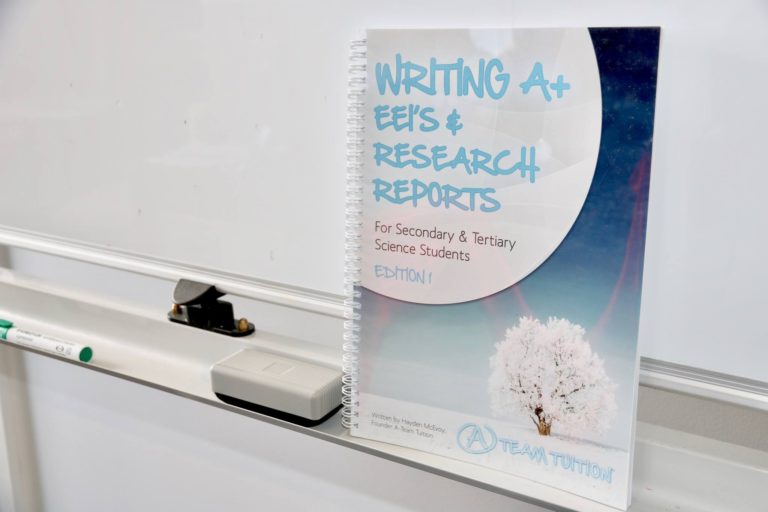
EEI stands for Extended Experimental Investigation, or Early… Okay, I can’t think of a second “E” word there, but you get the point. You really can’t start an EEI the night before.
To be honest, starting even a week before is crazy brave. Between the testing and the research, these things are months of work, and you should plan accordingly. If you start the second your teacher hands them out, you’ll be fine.
If you leave them till the last minute, they will become the hell that everyone says they are. Also, if you’re struggling, We have an EEI manual that can be a great investment, available here!
6. Do your research before you test
This one kind of goes hand in hand with the last one, but it makes a big enough difference to get its own heading. At the end of the day, there’s a certain amount of research into the topic you’re doing your EEI on that you’ll have to have done before you can write the final report.
The choice is up to you about whether you do that before you gather your data, or after. However, it’s really worth getting in early and getting this done before you test, because it will make your job a heap easier. Not only will it mean you actually know what you’re looking for when you’re gathering data, you’ll often find helpful tips online when you’re researching that will help you refine your experiment.
Plus, it means less for you to do at the end, when you’re busy tearing your hair out writing the report on your findings, so it’s a win-win.
7. Make a formula sheet, then ignore it
The last step should be done either throughout the term, or when you’re revising for your exam. Either way, it’s really important. Gather up all the formulae you’ve used throughout the term, write down what all the variables mean, and put this all onto one A4 page (they should probably fit, go double-sided if you have to).
You can use this for the start of your revision. Then, once you’re starting to get a handle on the topics you’re covering, try and use it less and less. Even if you know you’ll get a formula sheet in the exam, it’s worthwhile weaning yourself off it if you can. Otherwise, in the exam, you’ll waste heaps of time flicking back to look at the piece of paper with all the tiny little equations on it.
If you can get to the stage where you’re not relying on it, then you know that you’ve got those equations in your head, and you’re ready to rock this exam.
7.5. Don’t freak out!
Physics is hard, but people pass it all the time, and yes, people even get A’s. Follow these steps, and you will be one of them. Good luck!
The post How To Get An A In Physics – 7 Steps appeared first on A Team Tuition.
from A Team Tuition https://ift.tt/2q8zUhZ
via IFTTT
Tuesday, October 9, 2018
How To Get An A In Economics – 7 Steps
Economics, as you may know, can be a pretty weird subject.
After all, there aren’t many high school subjects that juggle mathematics with essays, hand-drawn graphs and a decent amount of educated guessing to produce crazy conclusions like why milk costs the Government millions of dollars every year.
If you’re struggling to figure out how you’re meant to get an ‘A’ in a subject which comes across as pretty darn strange, then you’ve come to the right place!
True, Economics might not seem like your other subjects – but just like you get guidelines in English and formulae in Mathematics, there is indeed a set of strategies and measures you can undertake in order to improve your grade. It’s worth noting, too, that these are the very same steps which I still use as an Economics Major at Bond University – no short-term tricks here, just proper strategies!
So, let’s begin!
1. Translate the Task Sheet into a Plan
It often seems like Economics task sheets are written in a different language; if we are able to translate all of this business jargon into plain old English, we stand a much greater chance of answering the task succinctly and effectively.
It’s easy to freak out when the task sheet outlines the topics that are required in your assessment piece. But hidden in all of these confusing words is something super useful; an assignment plan!
By categorising the types of topics that you are required to address in the essay, the task sheet has inadvertently given you a ready-to-go outline for your essay structure. Less work for you! Choose which topics are similar, pop your now-grouped-together topics into separate paragraphs, add a cute introduction and conclusion and boom – plan complete!
For example, consider an instance where the terms GDP, inflation, demographics, target-market, and supply-demand graphs were all mentioned in a task sheet which asked you to explain how the rapidly increasing output of goods and services within Australia will affect overall prices in a certain market.
You would first group together your like terms. Inflation rises because of GDP. Target-markets are a part of a demographic. And supply-demand graphs work with the law of supply and demand to demonstrate how prices will change in a certain market.
Then, you would use these groups of terms to create a body paragraph for each one which contributes towards your argument. An example of an Economics essay plan is shown below:
Introduction – Address task and what the essay is striving to achieve
Body Paragraph 1 – Introduce ‘inflation’ and ‘GDP’ and the impact that these factors have historically had on overall prices.
Body Paragraph 2 – Talk about what part of the demographic your target-market fits into, and thus explain how they are impacted by the previously mentioned inflation and GDP.
Body Paragraph 3 – Outline the law of supply and demand, including graphs, and visually demonstrate how the price of the product or service changed due to the rising GDP/inflation figures.
Conclusion – Summarise your findings (and provide a recommendation!)
See what I did there? I didn’t actually create any new ideas. I didn’t attempt to reinvent the wheel and produce the most mind-blowing piece of Economic theory ever seen. I simply reorganised a whole heap of topics that were handed to me on the task sheet to form the outline of an essay structure. Easy!
So, instead of putting on your I-look-okay-but-am-actually-freaking-out face when your teacher puts the task on your desk, relax! With a little bit of reorganising, you’ll have a finished assignment plan in no time.
2. Work with the Teacher

Economics is similar to humanities subjects in that the marking guide is often subjective. The result of this is that you need to work closely with your teacher to ensure that you are writing essays and answering exam questions in a style which is both factually correct and to the teacher’s liking.
What does ‘working with the teacher’ look like, though? It looks like several different things: paying attention to the way they describe and define economics; listening carefully to how they want you to structure answers and essays; and it always involves submitting a draft where possible.
Because a lot of Economic theory is in ‘the grey’ – i.e. the answer is not absolutely clear – the manner in which you present your findings becomes critically important.
Why is it that some of the greatest economists throughout history of directly opposing opinions on certain matters? Because plenty of Economics is not set in stone. Plenty of Economics is, in fact, based on assumptions which can be interpreted quite varyingly, thus requiring justification and explanation. Therefore, it is essential that you tailor your justifications and explanations to suit your teacher.
By ensuring you work cooperatively with your teacher’s preferences, you immediately stand a far greater chance of working towards that ‘A’.
3. Nail your Terms and Definitions
You’ve been studying all term. You’re itching to get into the end-of-term exam and smash out the extended essay. The teacher ushers the class in, you take a seat, the exam bell rings and you’re off! You make a flying start to your extended essay – but wait! You realise you’ve forgotten something terribly important…
Definitions!
Economics is built upon a language of confusing terms and business jargon; the importance of providing articulate and concise definitions to topics cannot be understated. Want to talk about how employment is affecting Gross Domestic Product? Explain Gross Domestic Product to me first. Want to discuss why inflation is good at a certain rate but not at a higher rate? Explain inflation to me first. Do you want to draw an elaborate set of supply-demand graphs to demonstrate the impact of negative publicity on a certain market? Explain the law of supply and demand to me first.
Getting the picture? Awesome. If you can cohesively bring in succinct definitions to each of your economic terms as you write an essay or extended exam answer, your knowledge and understanding criterion is going to go through the roof!
And when criteria go through the roof, so too do our chances of getting an ‘A’.
4. Think in Real Terms

Thinking exclusively in Economic terms can get a bit stressful.
When we talk in Economic terms, it is highly conceptual and very abstract. In other words, none of it actually seems to relate to anything real.
Consider this question: How will a change in consumer preference shift the demand curve? Will this shift subsequently put upward pressure on price and generate more economic profit for the firm in the market?
Don’t worry if you’ve already zoned out. After all, that question doesn’t actually mean anything real, does it? It’s just a whole heap of different concepts mashed together to prove something which only someone studying Economics would be able to understand.
Instead, consider this question: A Current Affair runs a one-hour program on the benefits of sourdough bread; they claim it will make you live longer, feel fitter, slim down and half your chance of heart-attack. Will the sales of sourdough bread go up or down because of this? Will the profits of sourdough bread vendors go up or down because of this?
Better? I thought so. It is fairly logical that good publicity for sourdough bread will lead to more sales and thus more profit. Thinking in real terms helps us give context and application to otherwise obscure concepts, thus making them far more palatable.
So, there you go; whenever faced with a dizzyingly conceptual question in that pesky Economics mid-term, try to think of it in terms which make sense to you, as opposed to relying exclusively on your understanding of Economic terms. In doing so, you’ve taken yet another step towards that ‘A’.
5. Connect the Dots – Linking Sources

Economics, like a crime scene, is filled with clues. Some of these clues are obvious, whilst others are almost invisible. It’s time to put on your detective hats and pull out the magnifying glass; in this section of How to Get an ‘A’ we are going to be looking into how to link sources (i.e. the clues) to produce a comprehensive and complex conclusion.
When posed with a broad question in Economics – perhaps something along the lines of “How does inflation affect employment?” – you as the Economist will be required to investigate a variety of sources, each with their own opinion or facts.
Consider these opinions and facts to be a pile of scrambled jigsaw puzzle pieces.
Identifying what these opinions and facts are will get you a ‘C’. Grouping together the pieces which look similar and show the same thing will reach a very respectable ‘B’. But what do we do if we want to reach that coveted ‘A’? We must strive to not only solve the puzzle in its entirety but to explain how each part of the puzzle interacts with the others.
If you’re having trouble imagining how this applies to Economics, let’s use Step 4 and think in Real Terms.
Consider the question posed before: “How does inflation affect employment?” Now, let’s think of pocket money.
Let’s assume you receive $10 per week in pocket money. You always spend the whole $10 on ten individual lollies, each costing $1. It’s a lovely routine and you enjoy it very much. Good for you.
Unfortunately, however, the rate of inflation is rising in Australia. The Reserve Bank of Australia, in turn, increases interest rates; in other words, how much money families and businesses have to pay back on their loans.
What does this mean for your lollies? It means the corner-store you buy them from has to suddenly increase the amount of interest it repays to the bank it received a loan from. More money being spent on the loan repayments means that they need to raise prices of everything in the store in order to compensate. To your dismay, you see the price of your $1 lollies has increased to a whopping $2.
Shocked, you decide to never shop there again. Your train of thought is mirrored by half of the customers who also shopped there. And so, the number of customers that shop in that corner-store is halved.
As a result of this, the manager of the corner-store dismisses half of his/her employees due to there being too many employees for the number of customers coming in.
Identifying that inflation will lower employment is akin to identifying what the facts of the situation are; a ‘C’, in other words. Pointing out the how and the why – i.e. explaining that the rate of repayment affected the cost of lollies which in turn detracted from customer-numbers and thus employees – is an excellent way of reaching a ‘B’. If we put this example in the context of an entire nation, however, we can explain that the reduced consumer spending is exactly what the Reserve Bank of Australia wanted when it raised interest rates and that this reduced spending will reduce the rate of inflation via increased unemployment and loan repayments. Now we are well positioned to achieve an ‘A’.
Just like detectives follow clues, figuring out and explaining the complex web of Economics is akin to solving a crime. The more clues we can prove to be correlated, the greater our chance of getting an ‘A’.
6. Don’t just Conclude – Provide Recommendations
This step is actually pretty easy. By this stage you’ve done all the hard work. You’ve already translated the task sheet, consulted your teacher, nailed your definitions, rethought the topic in real terms and connected the dots.
All that remains is for you to demonstrate your knowledge of Economics in one final way; by providing recommendations.
Consider this step the final few metres in a marathon. Sure, it’s only a fraction of the total distance, but without taking this final leap the entire race has been for nothing! Use all of the background information you have gathered, as well as the analysis provided in your essay, to craft a reasonable and insightful recommendation as to what path the relevant parties should pursue in order to maximise Economic efficiency.
So long as your recommendation is supported by evidence and Economic theory, the possibilities are limitless. Every morsel of data and every varied opinion collated during your research process has led to you being able to provide an astute recommendation. Back yourself! With logical justification, you can’t go wrong
7. Find Your Passion in Economics!

With all of the nitty-gritties out of the way, all that remains is for you to find your passion in Economics. Don’t worry, either; Economics doesn’t have to be as boring as it sometimes comes across. With the help of A Team’s Academic Personal Trainers, discovering a topic which is inspiring and stirs a sense of passion within you is entirely achievable. By collaborating and brain-storming with energetic and enthusiastic tutors, you will be able to best showcase your comprehensive understanding of Economics within a topic that will motivate you to produce your finest work.
You may even be surprised where you find a passion. After all, many things you already hold strong opinions about are, in fact, outcomes of Economic decisions.
People flood the street and holds riots when outrageous tax increases are enforced.
Families are forced into homelessness when Social Security allowances are decreased.
Legalising certain drugs may negatively impact our daily lives, however the Government revenue generated by regulating the sale of said drugs would create fabulous facilities for all of society to enjoy.
Cigarette sales produce millions of revenues in the form of tax but cost just as much in the form of health care. If health care costs outweigh tax revenues, we are losing twice; with both our health and our finances. If the revenues outweigh the costs, however, we’re essentially compromising our collective health for a bigger pay cheque.
The complexity of Economic issues is endless. The range of topics to address, too, is effectively limitless.
So, try not to roll your eyes when you find out what next term’s topic is. Because hidden inside that topic is a puzzle. A puzzle of complex, multi-dimensional Economic concepts all waiting to be discovered. Try to dig deeper than the surface of any Economic topic and you will find a vast and fascinating network of interrelated facts, figures, graphs and opinions. The contradictions, the corroborations, the agreements, the furious denials, the nuanced political background to Government Economics; they all weave together to create the fabric of perhaps the most stimulating and thought-provoking subject around.
What now? It’s time to follow these 7 Steps and start working towards your ‘A’ in Economics.
There are many things in Economics that remain uncertain – one thing you can be certain of is that you won’t regret following these Steps for one minute. Good luck!
The post How To Get An A In Economics – 7 Steps appeared first on A Team Tuition.
from A Team Tuition https://ift.tt/2NwFljS
via IFTTT
Thursday, August 30, 2018
How To Get An A In Chemistry
For students dreaming of becoming a doctor, pharmacist, engineer, concreter, painter or even a chef, you will have to be very familiar with Chemistry as it’s a subject that you will end up using on a daily basis in your chosen career. Chemistry forms the building blocks of life. It is a subject that is traditionally viewed as difficult because of the complex nature of chemical reactions and the unfamiliarity of the new language. This is usually where students crumble in Chemistry but with the right tools you’ll be on the track to success in no time!
Chemistry is far more theoretical than most people imagine. The theory studied in Chemistry, particularly at a High School level, is the starting point to the practical work that will come as students transition into the careers that were mentioned at the start of this blog. Whenever a Doctor prescribes a drug, they will always consider the chemical properties of the drug and how it will interact with the human body. This is just one example of Chemistry in action! Through this subject you will learn how to view the world in a different light, and appreciate the complex nature of the world we live in.
So without further ado, put on your safety googles and let’s get started on how you can ace Chemistry at school!
Tip 1: Know the history of Chemistry

In order to grasp the theoretical concepts that are studied in Chemistry, it is important to understand the history behind them. One fundamental principle of Science is that every concept or idea that you learn is based on a ‘theory’. By a theory’s very nature, we cannot definitively say that we ‘know’ something. For example, the structure of an atom cannot be known for certain. The development of the theory on the structure of atom started in the early 1800’s by John Dalton, but it has continued to develop and change through scientific experimentation up until 1918 when Neils Bohr proposed the current theory that is still used and accepted today. That’s not to say that it’s not still being experimented upon though! Just like the structure of an atom, it is only through experimentation that we can devise a theory to explain ideas. This applies for many Scientific principles and is a common theme across Science. Having a baseline understanding of Scientific history will allow you to know why scientists believe an atom has the structure it does, and maybe one day you’ll disagree and devise a ground-breaking experiment that wins you a Nobel Prize! Until you do, it is essential that you know to learn the theories that have preceded you!
Exam questions will often ask you to distinguish between the different atomic models by Dalton, Bohr and Thompson. Being able to describe the difference between these ideas is important and so is understanding how each model developed and extended or differentiated from another theory. Pay attention to the history, as it is only on the shoulders of giants that we can see further
Tip 2: Learn the Periodic Table using songs and mnemonics

Fundamental to your understanding of Chemistry lies the periodic table. Live it, love it, and learn it. Know what the different groups are. If you can memorise the first 20 elements of the Periodic Table, then this will aid you greatly. I used a funny song to remember it in Grade 9 and I still remember it now! Pay attention to the patterns within the Periodic Table, know your valence electrons and remember how to draw the shells.
The mnemonic that I use to remember the elements within the Periodic Table is, “Harry heard little Betty bought chocolate nibbles on Friday, near Nanna’s magical albatross. Silly people should clean around king’s castles.”
Every letter at the start of each word within this mnemonic corresponds to the first letter of an element. By knowing this pattern, you can arrange the Periodic Table on a scrap sheet of paper. Once you learn the columns of the periodic table and if it’s an Alkaline earth metal or a Halogen (groups within the periodic table), then you can determine the properties of the element, the valence electrons or determine if it will be an ionic or covalent bond.
Many people also use songs to recall the elements of the periodic table, particularly if they are not familiar enough with the chemical symbols. This song is useful if this is you! Remember that you will only need to memorise the first 20 elements (which is up to 0.29 sec in this video). Perhaps you can practice the song with a friend!
Tip 3: The secret to success is using formulas!
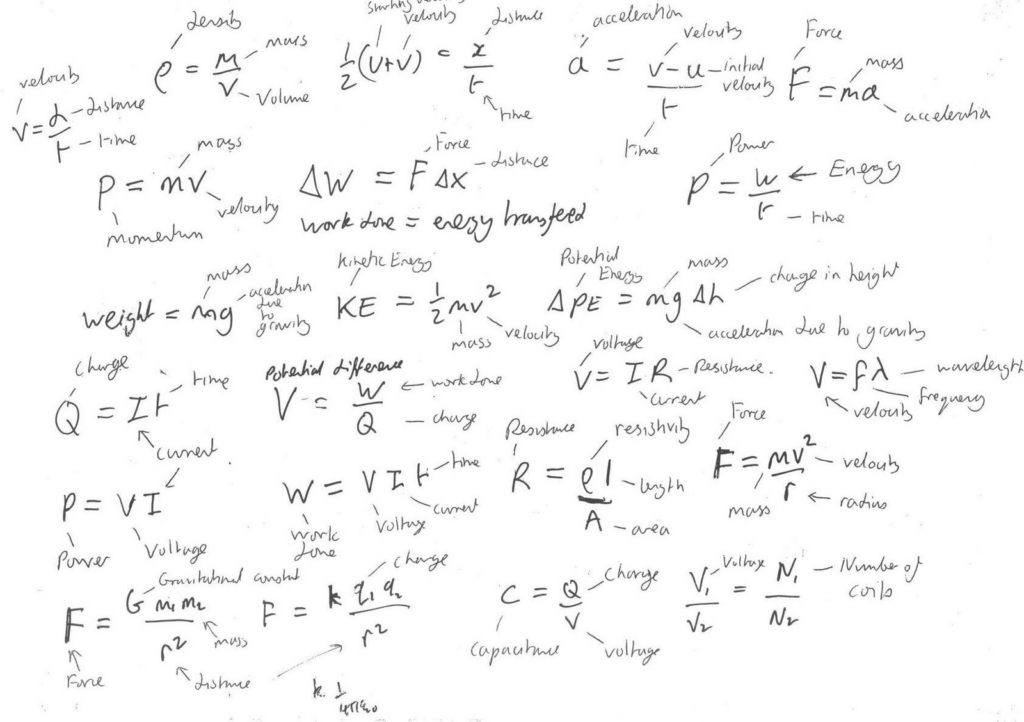
Conversion of known variables into the appropriate unit is one of the most common and disastrous errors I see students make. Even if you have correctly identified the correct equation and the variables, if you fail to use the correct units, then you simply won’t get the right answer! The easiest way to avoid this is to know what the SI units (International System of Units) are for each of the equations and keep track of them in your notebook. If in doubt, ask your teacher to explain the method of conversion or simply google the ‘SI units of equation XX’.
For example, if you are asked to calculate the force required to accelerate a race car that has a mass of 1.7 tonnes in a straight line at 1.8m/s2, the equation is F = ma. Here, F = the force in Newtons (N), m = the mass in kilograms (kg), and a = the acceleration in meters per second squared (m/s2).
If we calculate f where the mass is to be expressed in tonnes, the equation will be:
F = 1.7 x 1.8 m/s2
F = 3.06 Newtons
However, if we convert the mass into kg, then 1.7 tonnes = 1,700 kg. Accordingly, the equation will be:
F = 1,700 x 1.8 m/s2
F = 3,060 Newtons.
As you can see, there is a significant difference in the answers! It is important to always pay attention to the SI units when using an equation and to convert them before plugging them into the equation! A simple mistake like failing to do this, can affect your marks greatly!
Tip 4: Know how to write Extended Experimental Investigation (EEI) and Extended Response Questions (ERQ)
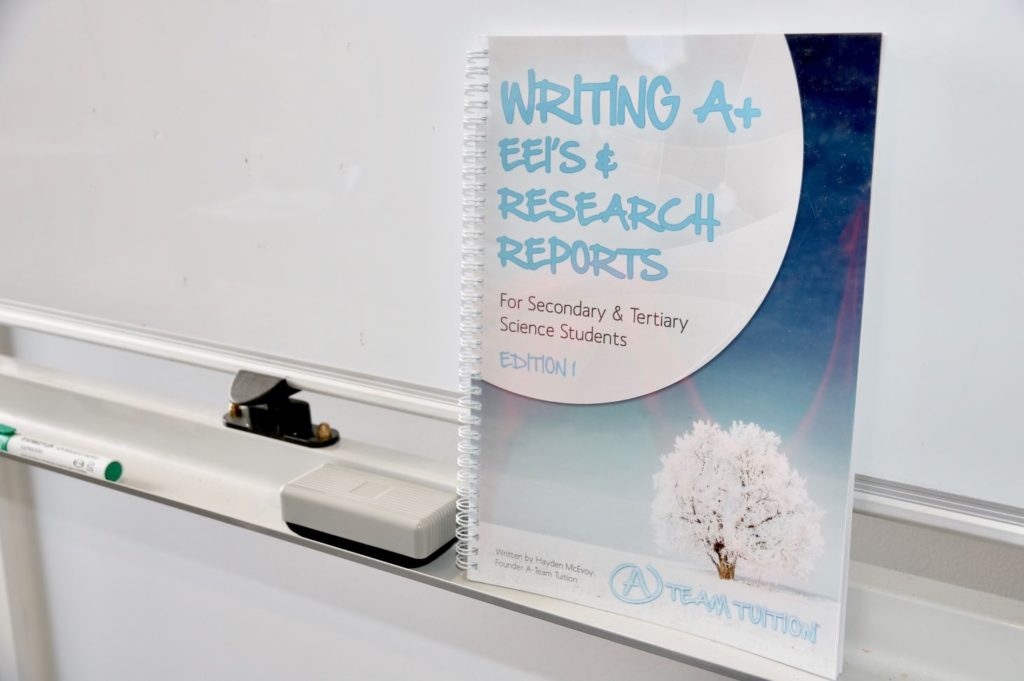
One of the biggest challenges faced by students while writing an EEI or an EQ is the research component of the task. Before starting assignments of this magnitude, students should develop research questions to aid in their searching. This is just one of the many steps students should take to jump towards an ‘A’ grade. Many students lose marks because they struggle to 1) breakdown the question posed for the task and 2) struggle to develop research questions appropriately before narrowing their search down to a particular sub-topic. Before you start writing or experimenting, try to spend a day just breaking down your questions and reading as widely as possible before narrowing your search.
Remember, you need to see the whole picture before you can start putting the jigsaw pieces together! So read widely, watch YouTube videos on the topic and ask questions if you don’t understand something - peers, tutors and teachers are all excellent resources! Once you know your topic, it is much easier to decide where your findings should go in each paragraph, and how you should best structure and design your experiment for the most effective outcome.
Tip 5: Know different chemical reactions and avoid common errors
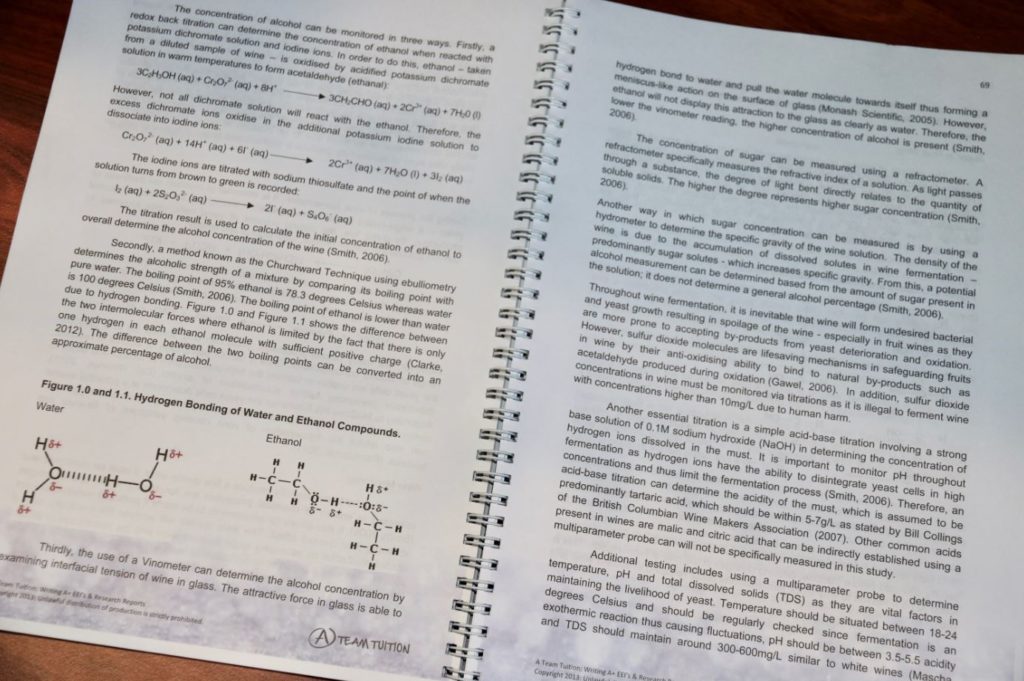
Responding to reactions is a classic question that you will likely find on a Chemistry exam and knowing this area of Chemistry will form the basis of most of the content that will be covered in the subject throughout High School. Often, you will be given either the reactants (starting material) or the products (the end result of a reaction) and be asked to fill in the blanks within the equation.
From my experience, students are generally confused as to how they are expected to know what the missing information is and how to answer questions of this kind. Just remember, there is nothing new under the sun! The reactions will follow predictable patterns which your teacher will run through in class. Decomposition, combustion, redox, and doubles displacement are all common types of chemical reactions that you will cross in your studies. You will most likely be expected to be able to identify these in an exam question. Knowing your Periodic Table and common compounds will really help at this stage! Before doing any calculations, it is always important to check the equation you are working with. Ask yourself: is it balanced? Do the amount of reactants equal the amount of products? If your answer is no, balance the equation first before moving on!
Firstly, count how many elements are on each side of the equation:
On the L hand side Fe = 2, O = 3 and C = 1
On the R hand side Fe = 1, O = 2 and C = 1
Since the numbers are not the same, we know that there are not the same number of products producing reactants. Equations are a scale. What is on one side of the equation, should be balanced on the other side.
To balance the equation, add numbers in front of the elements:
2Fe2O3 + 3C -> 4Fe + 3CO2
Knowing how to do this correctly will come with practice and there are plenty of helpful videos and practice questions online that you can use to help. Sometimes, this balancing act will form part of a question without expressly stating what you are required to do. Thus, it’s important to get yourself in the habit of checking the equations before you do anything with them
Tip 6: Sometimes, experiments don’t go to plan and that’s okay!

As students, and even as future scientists, it is important to acknowledge that we live and experiment in an imperfect world. Heat is lost to the environment, reactants don’t always fully react and sometimes, you just don’t have any idea about what’s happening! This is something that students need to keep in mind when completing assessment. When you’re doing an EEI, you start the experiment thinking you’ll be able to attain specific results and that the data will show XYZ. This is not always the case. Knowing this early on will ensure that you plan appropriately for time when things just don’t go the way you planned them. It is important to do this to ensure that you are not under time pressure to get the report finished. Take a deep breath and look at what you have. Look at the formulas and see what is known and what is unknown. Ask yourself: can you calculate anything with the data you’ve obtained? Can you see where you may have made an error? If so, write about it! Acknowledge where the experiment didn’t work perfectly and where the limitations were present. Identifying these things within your assignment is really what lifts an experiment from a B to an A!
In the discussion of your EEI or practical report write ups, an important point to always include is how the experimental process could have contributed to the discrepancies in the expected results. Was it a result of human error in measuring out products? Did the temperature in the room affect the experiment? This should only form a few sentences in any report (unless otherwise stated by the teacher) but is a fundamental aspect to include to lift the quality of any report.
Tip 7: Work in teams and ask for help!

You’re probably wondering how you’re supposed to identify all your errors, memorise the entire textbook and write an incredible report all within the short ten-week turnaround at school! Well, the biggest resource that you have has to be your peers around you. Even with tutors it can be difficult to really grapple with the concepts you need to know so studying in groups or pairs with your classmates can be effective. Identify someone that wants to achieve the same result as you and plan to work together. Sit together and make study notes or test each other’s knowledge with homemade flash cards. This helps with increasing your motivation to study and helps you identify gaps in your knowledge.
Ultimately, you should walk away from Chemistry understanding more about the world around you. Chemistry is interesting and fun, but it takes time, effort and dedication. Don’t be afraid to ask for help, many people have been where you are right now and pulled through!
The post How To Get An A In Chemistry appeared first on A Team Tuition.
from A Team Tuition https://ift.tt/2NBxgeM
via IFTTT



